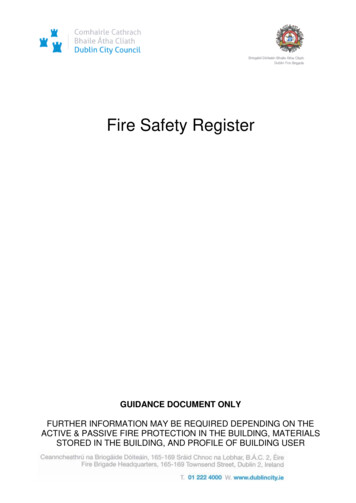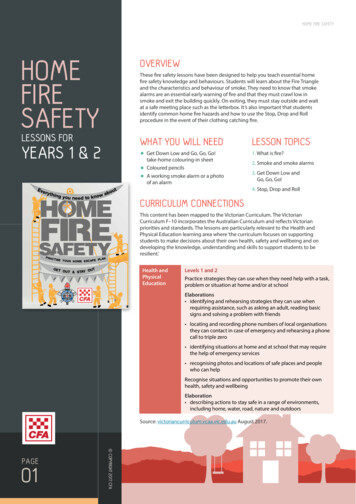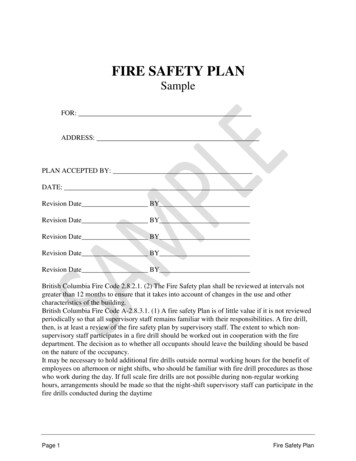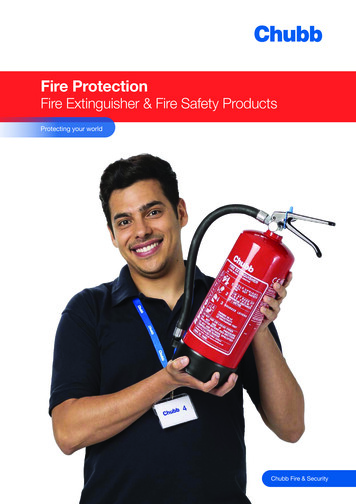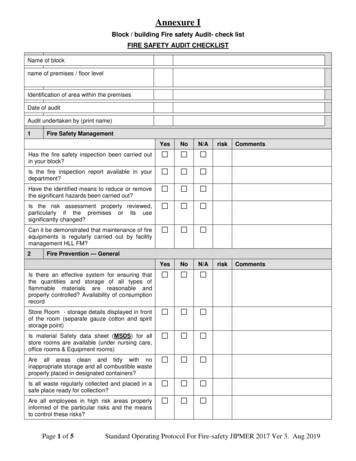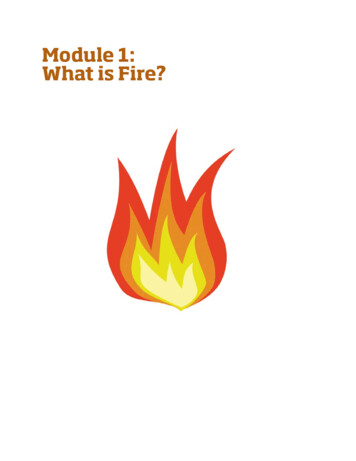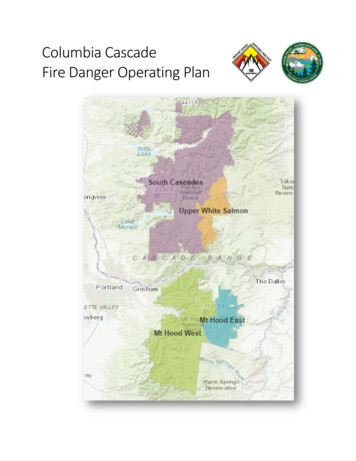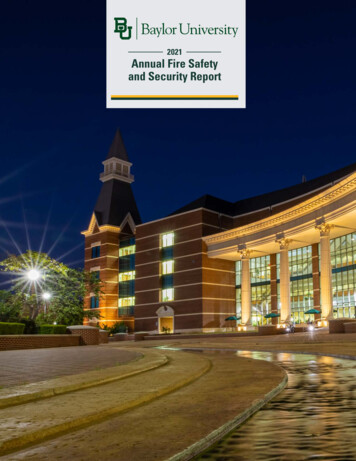
Transcription
2021Annual Fire Safetyand Security Report
2021 ANNUAL FIRE SAFETY AND SECURITY REPORTMESSAGE FROM THE PRESIDENT. . . . . . . . . . . . . . . . . . . . 4MESSAGE FROM ASSOCIATE VICE PRESIDENT FORPUBLIC SAFETY. . . . . . . . . . . . . . . . . . . . . . . . . . . . . . . . . . . . . 5ACCESSIBILITY TO INFORMATION &NON-DISCRIMINATION STATEMENT . . . . . . . . . . . . . . . . . 6ANNUAL FIRE SAFETY AND SECURITY REPORT. . . . . . . . 7Preparing the Annual Security Report . . . . . . . . . . . . . . . 7Disclosure of Crime Statistics . . . . . . . . . . . . . . . . . . . . . . 7Definitions of Reportable Crimes . . . . . . . . . . . . . . . . . 7Definitions of Geography. . . . . . . . . . . . . . . . . . . . . . . . 9Determining the Appropriate Segment or Segmentsof the Campus Community to Receive anEmergency Notification . . . . . . . . . . . . . . . . . . . . . . . . . 34Determining the Contents of theEmergency Notification . . . . . . . . . . . . . . . . . . . . . . . . . 35Procedures for Disseminating EmergencyInformation to the Greater Community . . . . . . . . . . . 35Enrolling in the University’s EmergencyNotification System. . . . . . . . . . . . . . . . . . . . . . . . . . . . . 35Timely Warnings. . . . . . . . . . . . . . . . . . . . . . . . . . . . . . . . 35Safety Notifications . . . . . . . . . . . . . . . . . . . . . . . . . . . . . 362020 BAYLOR UNIVERSITY CLERY CRIME STATISTICS.10EMERGENCY RESPONSE AND EVACUATIONPROCEDURES . . . . . . . . . . . . . . . . . . . . . . . . . . . . . . . . . . . . 36REPORTING CRIMES AND OTHER EMERGENCIES. . . . 26Emergency Management at Baylor University . . . . . . 36Reporting to University Police. . . . . . . . . . . . . . . . . . . . 26Evacuation and Relocation. . . . . . . . . . . . . . . . . . . . . . . 36Reporting to Other Campus Security Authorities . . . 27Other Emergency Procedures. . . . . . . . . . . . . . . . . . . . 36Voluntary, Confidential Reporting . . . . . . . . . . . . . . . . 28Active Shooter . . . . . . . . . . . . . . . . . . . . . . . . . . . . . . . . 36Pastoral and Professional Counselors –Confidential resources . . . . . . . . . . . . . . . . . . . . . . . . . 28Covid. . . . . . . . . . . . . . . . . . . . . . . . . . . . . . . . . . . . . . . . 37Explosion . . . . . . . . . . . . . . . . . . . . . . . . . . . . . . . . . . . . 37ABOUT THE BAYLOR UNIVERSITY POLICEDEPARTMENT . . . . . . . . . . . . . . . . . . . . . . . . . . . . . . . . . . . . 29Flood. . . . . . . . . . . . . . . . . . . . . . . . . . . . . . . . . . . . . . . . 37Role, Authority, and Training . . . . . . . . . . . . . . . . . . . . . 29Tornado. . . . . . . . . . . . . . . . . . . . . . . . . . . . . . . . . . . . . . 37Working Relationship with Local, State, and FederalLaw Enforcement. . . . . . . . . . . . . . . . . . . . . . . . . . . . . . . 29Drills, Exercises and Training . . . . . . . . . . . . . . . . . . . . . 38Working Relationship with Local, State, and FederalLaw Enforcement for Baylor’s Branch Campuses . . . 29CAMPUS SECURITY AWARENESS AND CRIMEPREVENTION EDUCATION PROGRAMS. . . . . . . . . . . . . . 31CRIMES INVOLVING STUDENT ORGANIZATIONS ATNON-CAMPUS LOCATIONS. . . . . . . . . . . . . . . . . . . . . . . . 33Daily Crime and Fire Log. . . . . . . . . . . . . . . . . . . . . . . . . 33EMERGENCY NOTIFICATIONS, TIMELY WARNINGS, &SAFETY NOTIFICATIONS. . . . . . . . . . . . . . . . . . . . . . . . . . . 33Emergency Notification . . . . . . . . . . . . . . . . . . . . . . . . . 33Notification Procedures. . . . . . . . . . . . . . . . . . . . . . . . 33Confirming the Existence of a Significant Emergencyor Dangerous Situation and Initiating the EmergencyNotification System. . . . . . . . . . . . . . . . . . . . . . . . . . . . . 34Branch Campus. . . . . . . . . . . . . . . . . . . . . . . . . . . . . . . 34Inclement Weather . . . . . . . . . . . . . . . . . . . . . . . . . . . . 37Security of and Access to Main CampusUniversity Facilities . . . . . . . . . . . . . . . . . . . . . . . . . . . . 38Security of and Access to Diana R. GarlandWaco School of Social Work. . . . . . . . . . . . . . . . . . . . 39Security of and Access to Diana R. GarlandHouston School of Social Work . . . . . . . . . . . . . . . . . 39Security of and Access to George W. TruettHouston Theological Seminary. . . . . . . . . . . . . . . . . . 39Security of and Access to Louise HerringtonSchool of Nursing . . . . . . . . . . . . . . . . . . . . . . . . . . . . . 40Security of and Access to Austin Executive MBAProgram . . . . . . . . . . . . . . . . . . . . . . . . . . . . . . . . . . . . . 40Security of and Access to Dallas Executive MBAProgram . . . . . . . . . . . . . . . . . . . . . . . . . . . . . . . . . . . . . 40Security of and Access to the Baylor in New YorkProgram . . . . . . . . . . . . . . . . . . . . . . . . . . . . . . . . . . . . . 40
BAYLOR UNIVERSITY’S RESPONSE TO SEXUAL ANDGENDER-BASED HARASSMENT AND INTERPERSONALVIOLENCE . . . . . . . . . . . . . . . . . . . . . . . . . . . . . . . . . . . . . . . 41Introduction . . . . . . . . . . . . . . . . . . . . . . . . . . . . . . . . . . . 41Baylor’s Commitment to Address Sexual andInterpersonal Misconduct. . . . . . . . . . . . . . . . . . . . . . . . 41Definitions. . . . . . . . . . . . . . . . . . . . . . . . . . . . . . . . . . . . . 42Baylor’s Sexual and Interpersonal MisconductPolicy Definitions. . . . . . . . . . . . . . . . . . . . . . . . . . . . . . . 43Additional Forms of Support . . . . . . . . . . . . . . . . . . . . 58Sanctions . . . . . . . . . . . . . . . . . . . . . . . . . . . . . . . . . . . . 58Sanctions Applicable to Students . . . . . . . . . . . . . . . . 58Sanctions Applicable to Faculty and Staff Members.59SEX OFFENDER REGISTRATION – CAMPUS SEX CRIMESPREVENTION ACT, MEGAN’S LAW, & THE ADAM WALSHCHILD PROTECTION AND SAFETY ACT . . . . . . . . . . . . . 60STUDENT CONDUCT. . . . . . . . . . . . . . . . . . . . . . . . . . . . . . 61Options for Complainants and Other Reporting Parties. 47The Student Conduct Code. . . . . . . . . . . . . . . . . . . . . . 61Victim Privacy and Confidentiality . . . . . . . . . . . . . . . . 49Parental Notification Policy . . . . . . . . . . . . . . . . . . . . . 61Confidentiality, Confidential Resources, QualifiedConfidentiality, and Privacy . . . . . . . . . . . . . . . . . . . . . 49MISSING STUDENT NOTIFICATION POLICY . . . . . . . . . 62Safeguarding the Privacy of Complainantsand Respondents. . . . . . . . . . . . . . . . . . . . . . . . . . . . . . 50Procedures Recommended by Law Enforcementfor Victims. . . . . . . . . . . . . . . . . . . . . . . . . . . . . . . . . . . . . 50Provisions. . . . . . . . . . . . . . . . . . . . . . . . . . . . . . . . . . . . . . 62BAYLOR UNIVERSITY POLICIES GOVERNINGALCOHOL AND OTHER DRUGS . . . . . . . . . . . . . . . . . . . . 63Policy Statement on Alcohol and Other Drugs . . . . . 63Personal Safety. . . . . . . . . . . . . . . . . . . . . . . . . . . . . . . . . . 51Legal Sanctions Applicable to Drug and Alcohol Use.64More Information. . . . . . . . . . . . . . . . . . . . . . . . . . . . . . . . 51Health Risks Associated with Drug and Alcohol Use. 65On and Off-Campus Resources . . . . . . . . . . . . . . . . . . . 51Counseling and Treatment Resources. . . . . . . . . . . . . 66Supportive Measures. . . . . . . . . . . . . . . . . . . . . . . . . . . . 53University Sanctions . . . . . . . . . . . . . . . . . . . . . . . . . . . 66Violence Against Women Act (V A W A)Sexual Violence Education Programs. . . . . . . . . . . . . . 53Additional Drug and Alcohol Abuse EducationPrograms. . . . . . . . . . . . . . . . . . . . . . . . . . . . . . . . . . . . . . 67BRIDGES: Building a Supportive Community andTaking Action . . . . . . . . . . . . . . . . . . . . . . . . . . . . . . . . . 53ALCOHOLEDU. . . . . . . . . . . . . . . . . . . . . . . . . . . . . . . . 67Sexual Assault Prevention for Graduate Students. . . 53ANNUAL FIRE SAFETY REPORT. . . . . . . . . . . . . . . . . . . . . 69Sexual Assault Prevention for UndergraduateStudents . . . . . . . . . . . . . . . . . . . . . . . . . . . . . . . . . . . . . 54Residence Hall Fire Drills . . . . . . . . . . . . . . . . . . . . . . . . 69Fire Safety . . . . . . . . . . . . . . . . . . . . . . . . . . . . . . . . . . . . . 69Set the Standard Campaign . . . . . . . . . . . . . . . . . . . . 54Fire Safety Education and Training Programs forStudents, Faculty and Staff. . . . . . . . . . . . . . . . . . . . . . . 69Student Responsible Employee Training . . . . . . . . . . 54Plans for Future Improvements in Fire Safety. . . . . . . 70Ongoing Student-Athlete Workshops . . . . . . . . . . . . 54Important Phone Numbers and Other ContactInformation. . . . . . . . . . . . . . . . . . . . . . . . . . . . . . . . . . . . 70Sexual Assault Prevention for Adult Learners . . . . . . 54How to be an Effective Bystander. . . . . . . . . . . . . . . . 54Every Choice Bystander . . . . . . . . . . . . . . . . . . . . . . . . 54Awareness Events, Outreach Initiatives, andWorkshops . . . . . . . . . . . . . . . . . . . . . . . . . . . . . . . . . . . 54Baylor Policy Statement on Campus AdjudicationProcess. . . . . . . . . . . . . . . . . . . . . . . . . . . . . . . . . . . . . . . . 55Residential Facility Fire Safety Policies. . . . . . . . . . . . . 70Fire Evacuation Procedures for Baylor UniversityMain Campus . . . . . . . . . . . . . . . . . . . . . . . . . . . . . . . . . . 70In the Event of a Fire. . . . . . . . . . . . . . . . . . . . . . . . . . . 70What it Means to Evacuate. . . . . . . . . . . . . . . . . . . . . . 71Resolution Procedures for the S I M Policy. . . . . . . . . 55How Will I Know to Evacuate?. . . . . . . . . . . . . . . . . . . 71Emergency Removal and Administrative Leave . . . . 55How to Evacuate. . . . . . . . . . . . . . . . . . . . . . . . . . . . . . 71Timing of Investigations and Related DisciplinaryProceedings. . . . . . . . . . . . . . . . . . . . . . . . . . . . . . . . . . 55Evacuation Assembly Points . . . . . . . . . . . . . . . . . . . . 71Disciplinary Resolution Procedures When theRespondent is a Student . . . . . . . . . . . . . . . . . . . . . . . 56Disciplinary Resolution Procedures When theRespondent is a Faculty or Staff Member . . . . . . . . . 57Adaptable Resolution Procedures. . . . . . . . . . . . . . . . 57Range of Penalties and Other Remedies Under theS I M Policy and Disciplinary Procedures. . . . . . . . . . . 582020 ON-CAMPUS STUDENT HOUSING FIRESAFETY SYSTEMS . . . . . . . . . . . . . . . . . . . . . . . . . . . . . . . . . 75FIRE STATISTICS FOR STUDENT HOUSINGFOR BAYLOR IN NEW YORK. . . . . . . . . . . . . . . . . . . . . . . . 762020 STUDENT HOUSING FIRE SAFETY SYSTEMSFOR BAYLOR IN NEW YORK. . . . . . . . . . . . . . . . . . . . . . . . 76
BAYLOR UNIVERSITY 2021 ANNUAL FIRE SAFETY AND SECURITY REPORT 3
MESSAGE FROM THE PRESIDENTTo the Baylor University Community:The mission statement of Baylor University charges us to provide aChristian-based educational experience within a caring community. This Annual Fire Safety and Security Report offers resources andguidelines that will help members of the community understandand contribute to the shared responsibility of overall safety atBaylor.Our ongoing commitment to the overall safety and security of ourstudents can be demonstrated, in part, by the following: A leading Department of Public Safety staffed by experiencedand expertly trained law enforcement and securityprofessionals; A fully accredited police department by the InternationalAssociation of Campus Law Enforcement Administrators; Two Full-time Clery professionals leading as experts in the field; Physical infrastructure, including more than 1,600 camerasas part of a campus-wide surveillance system that can identifycriminal and suspicious activity as it is occurring, as well asother emergency and safety systems; App-based mobile technologies for students to track and reportactivity, as well as communicate with law enforcement; Active police patrol in cars, bikes and on foot on campusthroughout the day and night; Security professionals positioned in high-occupancy or hightraffic building locations throughout all hours of operation; A nationally recognized Office of Equity, Civil Rights and TitleIX dedicated to the prevention of interpersonal and sexualviolence and management of such cases if they occur; and A Health Management Team of health and medical experts,faculty members, student life and human resourcesprofessionals, and other university administrators who providedaily COVID-19 guidance for the health, safety and wellbeingof our campus community.Baylor takes the safety and security of our students, faculty and staff very seriously. I encourage you to take the time to read this report thatoutlines our clear institutional policies concerning campus security, alcohol and drug use, crime reporting, crime prevention programs andfire safety information. By becoming aware of the services, training and education Baylor offers, everyone can be a part of achieving a trulysafe and welcoming educational environment for all students, faculty and staff.Sincerely,Linda A. Livingstone, Ph.D.President4 BAYLOR UNIVERSITY 2021 ANNUAL FIRE SAFETY AND SECURITY REPORT
MESSAGE FROM ASSOCIATE VICE PRESIDENT FOR PUBLIC SAFETYTo the Baylor University Community:Thank you for viewing the Baylor University Annual Fire Safetyand Security Report. The report is written to comply with therequirements of the Jeanne Clery Disclosure of Campus SecurityPolicy and Campus Crime Statistics, which is required of allinstitutions of higher education, whether public or private, whoparticipate in federal financial aid programs. It is our hope that thereport will be a valuable resource of safety information for you.The Baylor University Department of Public Safety (BUDPS) continues to strive to build and strengthen community partnershipsto help build a safer environment in which our students, faculty,staff, and visitors can thrive. By acting responsibly, getting involvedand caring for each other, we can enhance the overall safety ofthe campus.I have the privilege of leading the dedicated members of theBUDPS who care deeply about the Baylor community. Their effortsand sacrifice have enriched the Baylor experience for countlessmembers of the Baylor Family.We will never become complacent in the responsibility that has been given us to safeguard the calling God has on the lives’ of ourstudents, faculty and staff. We continually endeavor to enhance our services to the Baylor community through extensive training, enhancing safety programs, and gaining efficiencies through program reviews. As an example of our efforts, in April 2018 the Baylor PoliceDepartment was accredited by the International Association of Campus Law Enforcement Administrators (IACLEA). The accreditationprocess involved compliance with 214 standards representing best practices in campus law enforcement. The BUDPS is one of 66 campuslaw enforcement agencies in the nation who have achieved IACLEA accreditation.Please do not hesitate to contact me or my office if I can be of assistance.Best Regards,Mark ChildersAssociate Vice President for Public SafetyBaylor University Department of Public SafetyBAYLOR UNIVERSITY 2021 ANNUAL FIRE SAFETY AND SECURITY REPORT 5
ACCESSIBILITY TO INFORMATION & NON-DISCRIMINATION STATEMENTBaylor University complies with all applicable federal and statenondiscrimination laws. Baylor University admits students ofany race, color, national and ethnic origin, sex, age, disability, orveteran status to all the rights, privileges, programs, and activitiesgenerally accorded or made available to students at the school. Itdoes not discriminate on the basis of race, color, national and ethnic origin, sex, age, disability, or veteran status in administration ofits educational policies, admissions policies, scholarship and loanprograms, and athletic and other school-administered programs.Baylor University is controlled by a predominantly Baptist Boardof Regents and is operated within the Christian-oriented aims andideals of Baptists. The University is also affiliated with the BaptistGeneral Convention of Texas, a cooperative association of autonomous Texas Baptist churches. As a religiously-controlled institutionof higher education, the University is exempt from compliancewith some provisions of certain civil rights laws. As such, theUniversity prescribes standards of personal conduct that are consistent with its mission and values. This policy statement is neitherintended to discourage, nor is it in fact applicable to, any analyticaldiscussion of law and policy issues involved, or to discussions ofany recommendations for changes in existing law.6 BAYLOR UNIVERSITY 2021 ANNUAL FIRE SAFETY AND SECURITY REPORTDiscussions of these matters are both practiced and are welcomedwithin our curriculum.Further information may be obtained from the University StudentPolicies and Procedures webpage.Baylor University’s Title IX Coordinator is responsible for theinvestigation and resolution of all sex harassment matters, whichincludes sexual and gender-based harassment, sexual assault,sexual exploitation, stalking, intimate partner violence and retaliation. The Title IX Coordinator also organizes the University’s S I Mtraining and outreach programs. The office is located in the CliftonRobinson Tower, Suite 285, 700 S. University Parks Drive, Waco,Texas. The S I M Coordinator can be reached at (254) 710-8454 ore-mailed at TitleIX Coordinator@baylor.edu. Additional information about rights, responsibilities, reporting and resources arelocated at Baylor’s Equity, Civil Rights, and Title IX Office webpage,www.baylor.edu/equity.Victims of sex offenses are not required to but should stronglyconsider contacting the Baylor University Police Department at(254) 710-2222.
ANNUAL FIRE SAFETY AND SECURITY REPORTPreparing the Annual Security ReportBaylor University takes pride in contributing toward a caringcommunity through the shared institutional responsibility ofsafety and security.As such, all applicable state and federal reporting laws are adheredto. This includes the Jeanne Clery Disclosure of Campus SecurityPolicy and Campus Crime Statistics Act, which requires collegesand universities across the United States to disclose informationabout crime on and around their campuses occurring on Clerygeography. (20 USC§1092(f)).This report highlights safety practices and resources available toall current Baylor community members as well as prospectiveemployees and students. The report includes University policiesconcerning campus safety and crime prevention, sexual assault,alcohol and other drugs, and access to the campus. All policystatements contained in this report apply to all campuses unlessotherwise indicated.received reports of alleged crimes through an integrated computeraided-dispatch system/records management system. After an officerenters the report in the system, a department administrator reviewsthe report to ensure it is appropriately classified in the correctcrime category. The Baylor University Police Department (BUPD)periodically examines the data to ensure that all reported crimesare recorded in accordance with the crime definitions outlined inthe FBI Uniform Crime Reporting Handbook and the FBI NationalIncident-Based Reporting System Handbook (sex offenses only). Inaddition to the crime data maintained by BUPD, statistic requestsare sent to local law enforcement agencies, as well as CampusSecurity Authorities (CSAs) having significant responsibilities forstudents, employees, and University activities.Statistics within this report generally reflect the number ofcriminal incidents reported to various authorities. Statisticsreported for sub-categories on liquor laws, drug laws, andweapons offenses represent the number of people arrested orreferred to campus student conduct authorities for respectiveviolations. These statistics do not reflect convictions of guiltand may include unpreventable duplication due to anonymousreports.The Clery Compliance Office prepares the Annual Fire Safety andSecurity Report through collaboration with several Universitypartners such as Baylor University Department of Public Safety,Student Life, Campus Living & Learning, S IM , designated CampusSecurity Authorities from all Baylor campuses, and local lawenforcement agencies that serve Baylor’s main campus and branchcampuses. In addition, BUDPS maintains close relationships withall police departments where Baylor University owns or controlsproperty to ensure the timely distribution of criminal incidents.Below you will find reportable Clery crime and geography definitions, as well as crime statistics for the seven Baylor Universitycampuses.Once data has been reviewed for accuracy for each Baylor campus,the University distributes a notice of the availability of this AnnualFire Safety and Security Report by October 1st of each year to everymember of the University community. This includes all constituents of the Baylor campuses.CRIMINAL HOMICIDE Negligent manslaughter is the killing ofanother person through gross negligence.Printed copies of this report are available upon request bycontacting the Baylor University Police Department at (254)710-2222 or in person at the Baylor University Police Departmentbetween the hours of 8 a.m. and 5 p.m. Monday through Friday.www.baylor.edu/annualcleryreport/Disclosure of Crime StatisticsStatistics concerning reported crimes that occurred on the Baylorcampus and the Baylor branch campuses for the previous threeyears are included in this report. This includes Clery crimes thatoccurred within property owned, leased, or controlled by BaylorUniversity, as well as, Clery crimes that occurred on public property immediately adjacent to or on thoroughfares running throughthe campuses. This report also includes any crime occurring onproperty utilized for the purposes of COVID-19 quarantine.The Clery Compliance Office collects crime statistics throughseveral methods. Police dispatchers and officers enter all directlyDEFINITIONS OF REPORTABLE CRIMESCRIMINAL HOMICIDE Murder and nonnegligent manslaughter isthe willful (nonnegligent) killing of one human being by another.SEX OFFENSES Any sexual act directed against another person,without the consent of the victim, including instances where thevictim is incapable of giving consent.RAPE The penetration, no matter how slight, of the vagina or anuswith any body part or object, or oral penetration by a sex organ ofanother person, without the consent of the victim. This definitionincludes any gender of victim or perpetrator.FONDLING The touching of the private body parts of anotherperson for the purpose of sexual gratification, without the consentof the victim, including instances where the victim is incapableof giving consent because of his/her age or because of his/hertemporary or permanent mental incapacity.INCEST Sexual intercourse between persons who are related toeach other within the degrees wherein marriage is prohibitedby law.STATUTORY RAPE Sexual intercourse with a person who is underthe statutory age of consent.BAYLOR UNIVERSITY 2021 ANNUAL FIRE SAFETY AND SECURITY REPORT 7
ROBBERY The taking or attempting to take anything of value fromthe care, custody, or control of a person or persons by force orthreat of force or violence and/or by putting the victim in fear.AGGRAVATED ASSAULT An unlawful attack by one person uponanother for the purpose of inflicting severe or aggravated bodilyinjury. This type of assault usually is accompanied by the use of aweapon or by means likely to produce death or great bodily harm.BURGLARY The unlawful entry of a structure to commit a felonyor a theft. For reporting purposes, this definition includes: unlawful entry with intent to commit a larceny or a felony; breaking andentering with intent to commit a larceny; housebreaking; safecracking; and all attempts to commit any of the aforementioned.MOTOR VEHICLE THEFT The theft or attempted theft of amotor vehicle.ARSON Any willful or malicious burning or attempt to burn, withor without intent to defraud, a dwelling house, public building,motor vehicle or aircraft, personal property of another, etc.Hate CrimesHate Crimes include all crimes listed above that manifest evidencethat the victim was chosen based on one of the categories of biaslisted below, plus the following crimes.HATE CRIME A crime that manifests evidence that the victim wasintentionally selected because of the perpetrator’s bias againstthe victim. The categories of bias include the victim’s actual orperceived race, religion, gender, gender identity, sexual orientation,ethnicity, national origin, and disability.Categories of BiasRACE A preformed negative attitude toward a group of personswho possess common physical characteristics genetically transmitted by descent and heredity, which distinguish them as a distinctdivision of humankind.GENDER A preformed negative opinion or attitude toward a person or group of persons based on their actual or perceived gender.GENDER IDENTITY A preformed negative opinion or attitudetoward a person or group of persons based on their actual orperceived gender identity, e.g., bias against transgender or gendernon-conforming individuals.RELIGION A preformed negative opinion or attitude toward agroup of persons who share the same religious beliefs regardingthe origin and purpose of the universe and the existence or nonexistence of a supreme being.SEXUAL ORIENTATION A preformed negative opinion or attitudetoward a group of persons based on their actual or perceived sexualorientation (i.e., a person’s physical, romantic, and/or emotionalattraction to members of the same or opposite sex.ETHNICITY A preformed negative opinion or attitude toward agroup of people whose members identify with each other, througha common heritage, often consisting of a common language,common culture (often including a shared religion) and/orideology that stresses common ancestry. The concept of ethnicitydiffers from the closely related term “race “in that “race” refers togrouping based mostly upon biological criteria, while “ethnicity”also encompasses additional cultural factors.LARCENY/THEFT The unlawful taking, carrying, leading, or ridingaway of property from the possession or constructive possessionof another. Attempted larcenies are included. Embezzlement,confidence games, forgery, worthless checks, etc., are excluded.Examples include, thefts of bicycles or automobile accessories,shoplifting, pocket-picking, stealing of any property or articlethat is not taken by force and violence or by fraud, and attempted larcenies.NATIONAL ORIGIN A preformed negative opinion or attitude toward a group of people based on their actual or perceived countryof birth.SIMPLE ASSAULT An unlawful physical attack by one person uponanother where neither the offender displays a weapon, nor thevictim suffers obvious severe or aggravated bodily injury involvingapparent broken bones, loss of teeth, possible internal injury,severe laceration, or loss of consciousness.Arrests and Disciplinary Referrals for Violationof Weapons, Drug Abuse and Liquor LawsINTIMIDATION To unlawfully place another person in reasonablefear of bodily harm through the use of threatening words and/orother conduct, but without displaying a weapon or subjecting thevictim to actual physical attack.DESTRUCTION/DAMAGE/VANDALISM OF PROPERTY(EXCLUDING AR
BAYLOR UNIVERSITY 2021 ANNUAL FIRE SAFETY AND SECURITY REPORT MESSAGE FROM THE PRESIDENT To the Baylor University Community: The mission statement of Baylor University charges us to provide a Christian-based educational experience within a caring communi-ty. This Annual Fire Safety and Security Report offers resources and


